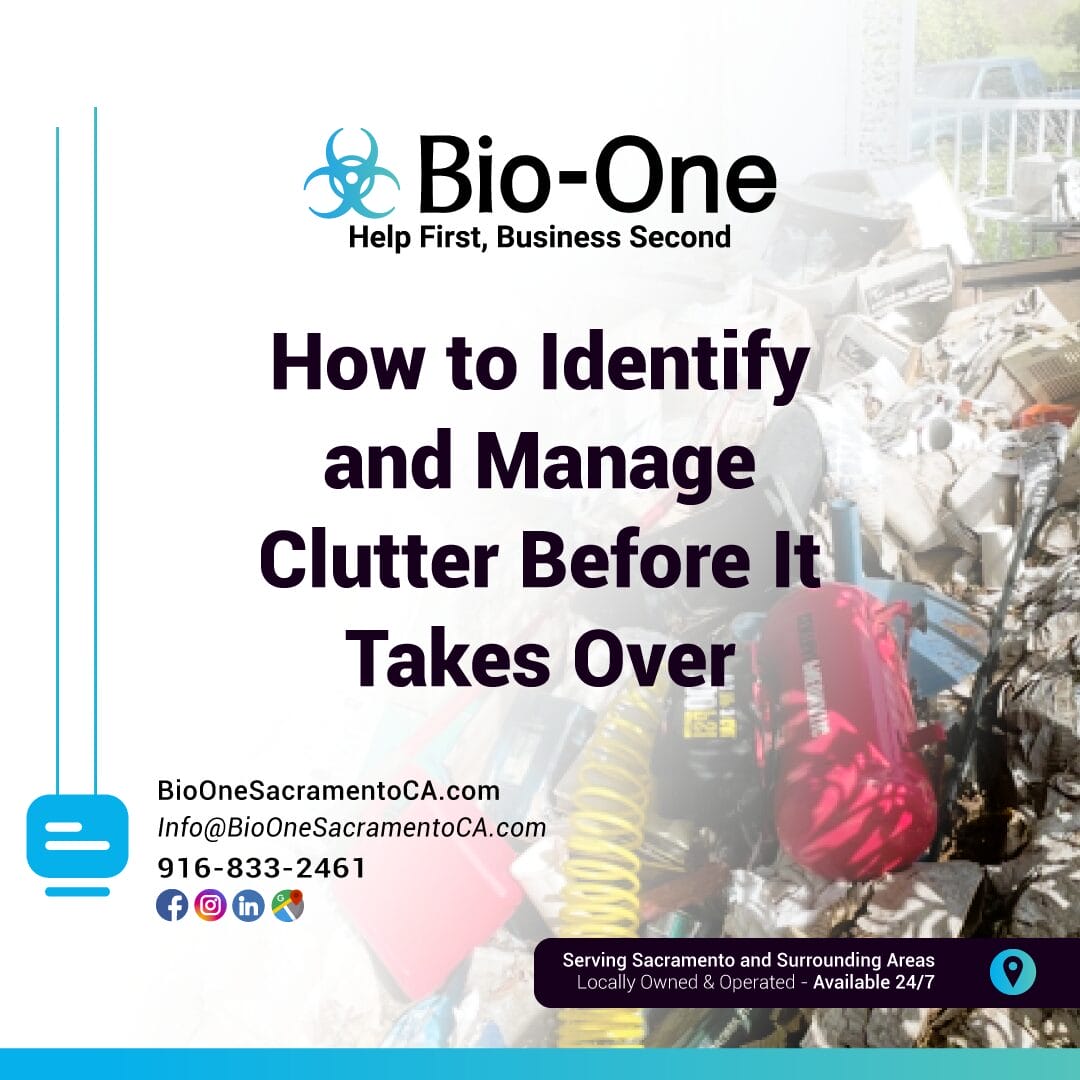
Clutter has a sneaky way of piling up when we’re not paying attention. One day, you’re organizing your belongings, and the next, you can’t find your car keys under a mountain of unopened mail. The line between a full yet functional home and overwhelming disorganization can blur quickly. That’s why understanding clutter management is essential to maintaining a comfortable, stress-free environment.
But don’t worry—you’re not alone in facing down the piles. At Bio-One of Sacramento, our expert team specializes in restoring order, even in the most challenging hoarding situations. Here’s how you can spot the trouble before it grows and keep your living spaces under control.
Clutter doesn’t always look the same in every home, but there are some clear signals that it’s starting to take over. Here are a few red flags to watch for:
Once you've identified the issue, the next move is action. With the right approach, you can stay on top of clutter before it becomes a bigger problem. Here's how:
Grab three boxes and label them "Keep," "Donate," and "Trash." Go through your belongings one area at a time, placing each item into a category. Stick to this system; it’s your first step to reclaiming order.
Once you’ve decided what to keep, assign a specific place for it. Storage bins, labels, and shelving can help ensure everything has its own spot. It’s harder for clutter to build up when everything lives where it should.
Just like cleaning, clutter management is easier in small doses. Set aside 15 minutes a day or schedule weekly decluttering sessions to prevent things from piling back up.
For every new item you bring into your home, remove an old one. This simple habit helps balance what you own and stops clutter from creeping back in.
Sometimes, clutter issues can spiral into hoarding situations. If you’re feeling overwhelmed, there’s no shame in asking for support.
At Bio-One of Sacramento, we understand that clutter doesn’t just pile up physically. It can also take a toll on your peace of mind. If you’re faced with a situation that feels too overwhelming to handle alone, know that we’re here to help.
Our expert team has the experience, compassion, and tools required to tackle everything from basic clutter management to complex hoarding cleanups. No matter the situation, our goal is to restore your space and your peace of mind. With our assistance, you can move forward into a cleaner, healthier environment.
Clutter doesn’t have to control your life. By taking small steps or enlisting professional help, you can reclaim your home and safeguard your wellbeing. Remember, your environment has a direct impact on your mental and emotional state. A well-organized space creates room for clarity and calm.
If you’re ready to tackle clutter for good, reach out to Bio-One of Sacramento. Our caring and capable team is ready to support you every step of the way.
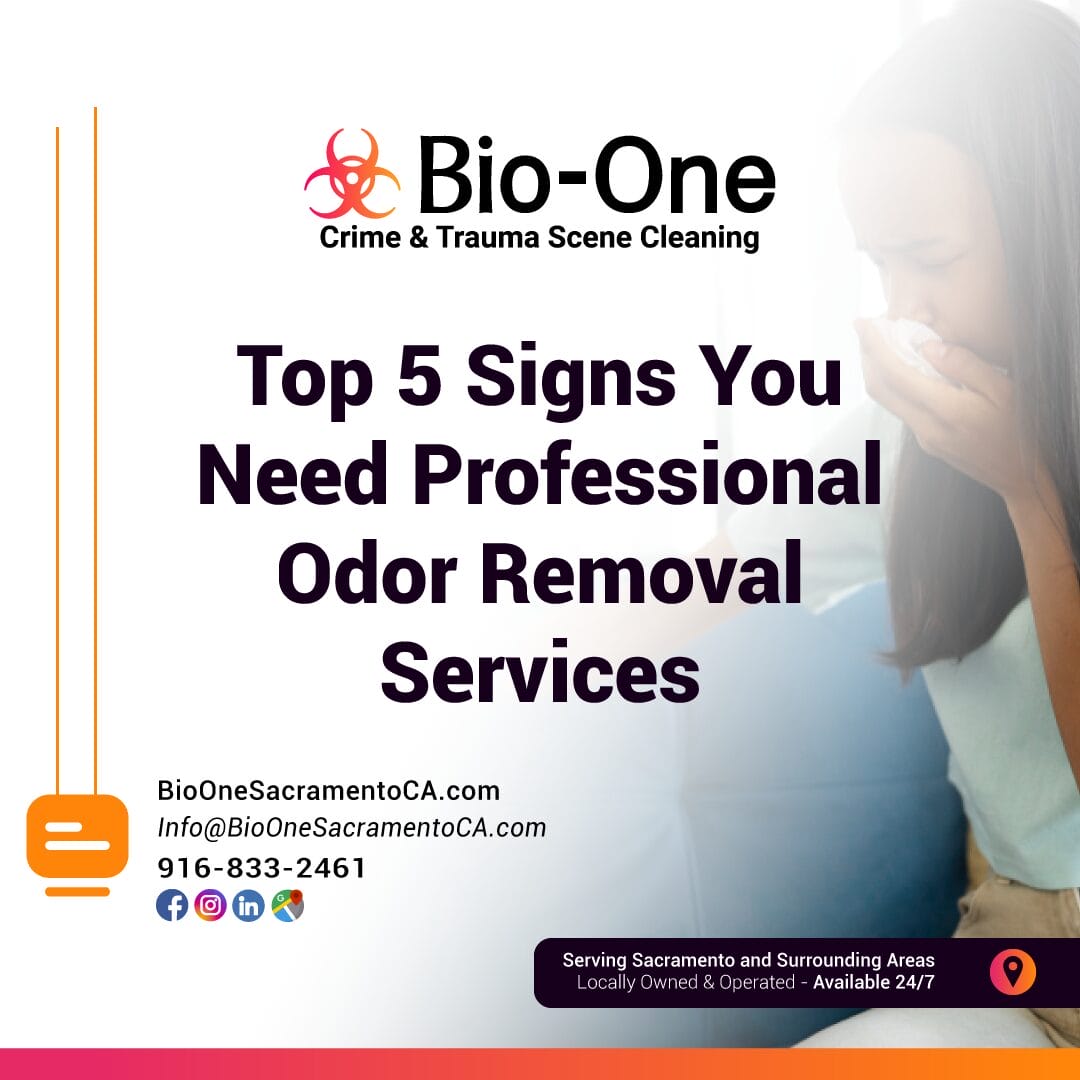
Unpleasant odors can affect your living or working environment far more than you might think. They can linger, disrupt comfort, and even pose health risks. While temporary fixes like candles or air fresheners might mask smells, some odors demand expert attention. Here are the top five signs you need professional odor removal services, and why Bio-One of Sacramento is your trusted partner for tackling these issues effectively.
If you’ve cleaned every surface, opened every window, and still can’t shake an unpleasant smell, it’s likely time to call in professionals. Persistent odors often stem from hidden issues like pet accidents beneath floorboards, mold growth inside walls, or deeply embedded smells in carpets. Professional odor removal services are equipped with specialized tools and techniques to locate and eliminate the source rather than covering it up. At Bio-One of Sacramento, we excel in finding the root of the problem and neutralizing it completely.
Have you tried every DIY remedy in the book, only to find the smell creeping back? Odors caused by smoke, chemical spills, or biological contaminants are notoriously difficult to remove with over-the-counter solutions. DIY methods can sometimes even worsen the problem by spreading odor particles rather than removing them. Bio-One of Sacramento uses advanced equipment and industry-approved methods to ensure even the most stubborn smells are permanently eliminated, saving you time and frustration.
Certain odors aren’t just unpleasant; they can be harmful. Moldy smells might indicate toxic mold spores in the air, while a musty scent might point to water damage leading to bacteria and fungi growth. Foul odors from things like pet waste or decomposing materials can harbor harmful pathogens. If you or your family experience headaches, respiratory issues, or other health problems linked to an odor, getting professional odor removal is imperative. Bio-One of Sacramento specializes in handling these hazardous situations safely and effectively.
Some situations simply call for an expert. For instance, smoke odors after a fire, sewage backups, or decomposition odors in certain environments can linger for years if not properly addressed. These situations often require industrial-grade tools and robust cleaning protocols that professionals like Bio-One of Sacramento can provide. Our team is certified and trained to handle even the toughest odor removal jobs with care and efficiency.
If you’re selling or renting out a property, lingering odors can deter potential buyers or tenants. Similarly, a smelly storefront or office can make a poor impression on clients. Professional odor removal ensures your space smells clean and inviting, which can significantly boost its appeal. Bio-One of Sacramento works discreetly and promptly to help you restore confidence in your property, ensuring a pleasant environment for guests, clients, or potential buyers.
At Bio-One of Sacramento, we understand that odor issues can be overwhelming and even embarrassing. That’s why we approach every job with sensitivity, expertise, and a focus on solving the problem for good. Our team uses state-of-the-art equipment, eco-friendly cleaning solutions, and proven techniques to eliminate even the toughest odors at their source.
Whether you’re dealing with an odor caused by everyday life, a disaster, or specific contamination, we’re here to help. Don’t wait for the smell to grow worse or cause more problems. Trust Bio-One of Sacramento for top-tier, professional odor removal services tailored to your needs!

Dealing with a trauma situation that requires professional cleanup is not only emotionally overwhelming but often comes with unique challenges. Ensuring the cleanup is done safely, professionally, and with care is crucial for restoring your space and providing peace of mind. However, not all cleanup services offer the same level of expertise, compassion, or attention to detail. To help you make an informed decision, here are the top questions you should ask before hiring a trauma cleanup professional.
Trauma cleanup is a highly specialized field that requires proper licensing and certification. A reputable company should have proof of certification from organizations like the Occupational Safety and Health Administration (OSHA) or similar bodies that govern biohazard handling. Ask if their technicians are trained in bloodborne pathogen handling, biohazard waste disposal, and other safety guidelines. This ensures they’re equipped to manage hazardous materials correctly.
Experience matters in trauma cleanup. Companies with years of experience in the field are more likely to have encountered a range of situations and know how to address them effectively. Whether the cleanup involves blood, bodily fluids, unattended deaths, or hoarding situations, an experienced company brings not only technical expertise but also an understanding of the emotional toll these incidents can have.
Ask how long the company has been operating, as well as what types of scenarios they’ve handled. Specific examples can give you confidence in their capabilities.
Safety is paramount in trauma cleanup to protect both the professionals and the property’s occupants. A good company should adhere to strict safety protocols, including the use of personal protective equipment (PPE), proper containment methods, and medical-grade disinfectants. Additionally, they should ensure thorough decontamination to prevent the spread of disease or residual contamination.
Trauma situations are often emotionally charged and deeply personal. The last thing you want during such a time is to feel judged or scrutinized. Look for professionals who prioritize compassion and discretion. A company like Bio-One of Sacramento, for instance, uses unmarked vehicles to maintain privacy and approaches every scene with sensitivity and respect.
“How does your team handle emotionally sensitive situations, and what steps do you take to ensure my privacy is protected?”
Trauma cleanup services can be costly depending on the severity of the situation. Many reputable companies work directly with insurance providers to help ease the financial burden. Confirm whether the company can assist with filing insurance claims and if they have experience navigating the paperwork involved.
Modern trauma cleanup requires advanced tools and techniques to ensure thorough decontamination. Ask about the types of equipment the company uses. This might include ozone generators, air scrubbers, or hospital-grade disinfectants. If a company uses outdated or subpar tools, the cleanup may not be as effective as it should be.
Word of mouth and online reviews are powerful tools for gauging the quality of a service provider. A reputable company will often have testimonials or reviews from satisfied customers. You can also ask if they’re willing to provide references for additional reassurance.
Look for feedback that highlights professionalism, compassion, and effectiveness. For Bio-One of Sacramento, client reviews emphasize how the team goes above and beyond to help families during difficult times.
Trauma cleanup is often urgent. Time-sensitive situations, including suicides, crime scenes, and decomposition scenarios, can pose health risks if left unaddressed. Ask the company how soon they can arrive on-site and whether they offer 24/7 availability.
A quick response minimizes further damage to the property and helps you start moving forward sooner.
Trauma cleanup might require more than just cleaning. It could involve odor removal, remediation, or even working in collaboration with other professionals like coroners or property managers. Make sure the company you hire offers a comprehensive range of services tailored to your specific needs.
Trustworthy trauma cleanup professionals take pride in their work and deliver results that leave clients satisfied. Ask if the company offers a satisfaction guarantee. This reflects confidence in their services and reassures you that they won’t leave the job until it meets their standards.
At Bio-One of Sacramento, we understand that trauma cleanup is about more than removing contaminants; it’s about helping individuals and families move forward with dignity and care. Here’s what sets us apart:
Choosing the right trauma cleanup professional can make all the difference during a difficult time. By asking the right questions and ensuring the company you hire has the qualifications, experience, and compassion needed for the job, you’re taking the first step toward restoring your space.
If you find yourself needing trauma cleanup services, don’t hesitate to reach out to Bio-One of Sacramento. We’re here to help, 24/7, with professionalism and care.
---
Contact Bio-One of Sacramento Today
Call us at 916-833-2461 or visit our website to learn more about our trauma cleanup services. Assistance is just a call away.

Undergoing a hoarding cleanup is a significant step toward improving your living environment and overall well-being. At Bio-One of Sacramento, we understand the challenges involved in reaching this milestone and the ongoing effort it takes to maintain it. Preventing hoarding relapse can be difficult, especially when emotional and psychological factors are at play, but with the right tools, support, and mindset, a clutter-free and healthy home is achievable. Here are our top tips for keeping your home organized and preventing a return to hoarding behaviors.
Establishing a consistent routine is one of the best ways to prevent clutter from building up again. Start by dedicating small amounts of time each day or week to tidying up specific areas of your home. For example:
When bringing a new item into your home, make it a habit to remove something old. For instance, if you buy a new piece of clothing, donate or dispose of one you no longer wear. This practice ensures you maintain balance in your possessions and prevents unnecessary accumulation.
Define clear purposes for each room or area in your home. For example, keep the kitchen for cooking and eating, rather than using it as a storage space. Having designated areas for specific functions can help you stay organized and prevent items from creeping into spaces where they don't belong.
Hoarding behaviors often stem from emotional stress, trauma, or attachment to items. Pay attention to triggers that might lead to impulsive buying or difficulty letting go of possessions. Whether it’s a sentimental association or fear of future scarcity, recognizing these triggers can help you manage them in a healthier way. Journaling about your feelings or talking to a trusted friend can also provide clarity and support.
If hoarding feels overwhelming and difficult to manage on your own, reaching out to a therapist or counselor can be a life-changing step. Mental health professionals are trained to help individuals understand the root causes of their behaviors and develop effective coping strategies. Seeking therapy is a sign of strength, not weakness, and plays a crucial role in fostering personal growth.
It’s important to break the stigma surrounding mental health support and recognize that everyone deserves guidance in their struggles. Taking this step can empower you to regain control and create a healthier, more organized living environment.
Periodic decluttering is essential to keep your home clear and manageable. It doesn't have to be overwhelming! Start with small areas like a drawer or shelf, and slowly work your way up to larger spaces. Ask yourself these questions as you sort through items:
Lean on family, friends, or community groups who understand what you’re going through. Having supportive people around can make all the difference. They can help hold you accountable, assist with organizational projects, or simply offer encouragement when you need it.
Online or in-person hoarding support groups are also available and can provide a safe space to share experiences and gain insights from others who have faced similar challenges.
Maintaining a clutter-free home isn’t about perfection; it’s about progress. Celebrate small wins along the way, like clearing out a single drawer or completing a task on your maintenance routine. Recognizing these achievements can boost your confidence and motivate you to keep going.
Instead of relying on shopping or acquiring items for comfort, try incorporating new activities into your routine. These might include:
Relapse prevention is a process, and it’s important to approach it with understanding and kindness. If small setbacks occur, know that it’s part of the journey, not the end of the road. Be compassionate with yourself and recognize the courage it took to begin this transformation. Similarly, if you’re supporting a loved one who struggles with hoarding, remember to offer encouragement and empathy.
At Bio-One of Sacramento, we’re committed to helping individuals and families not just with hoarding cleanups but also with moving toward healthier lives. Preventing hoarding relapse is possible and starts with small, manageable steps. The most important part of this process is remembering you’re not alone. Whether you need advice, resources, or renewed support, we’re here 24/7 to help you move forward with compassion and care. If you or a loved one needs assistance, reach out to our team at any time!

Losing a loved one affects everyone differently. While you may not know what to do or say to support someone who is grieving, being there for your loved one and showing them that you care during their time of need is one of the most valuable ways to support them. In this blog post, we will provide simple tips on how to help a loved one with grief, so you can help them in their transition.
The most important thing you can do for someone who is grieving is to be there. Listen to them, hold their hand, or sit silently with them. Your presence might be reassuring and comforting. People often apologize for crying, but it's okay to let them get emotional and express themselves. Avoid minimizing their pain or telling them that everything will be all right.
Everyone grieves differently, and it's important to respect their process. Allow them to feel what they're feeling without judgment or pressure.
Grief can consume much energy and leave little room for everyday tasks. Offer practical help by cooking meals, walking their dog, cleaning, or running errands. These simple tasks can make a big difference and help ease the burden of the person grieving, always respecting their boundaries and preferences.
Grief is a journey, and it takes time to heal. Checking in regularly and making time for your loved one on a regular basis shows them that you haven't forgotten about them. Even if it's just a quick text message or phone call, small gestures can help and are greatly appreciated.
Everyone grieves differently, and we all have coping mechanisms that help us deal with stress and sadness. It's important to support your loved one's own way of coping. If they want to talk about the person they've lost, listen. If they want to take a break from talking about it, respect their need for space.
Grief can lead to various emotions such as anger, sadness, regret, and guilt, which can be overwhelming. Avoid being judgmental, critical, or dismissive of their feelings and emotions. Remember that grief isn't something that can be "fixed," and we cannot speed up the healing process. As we've mentioned: be there, listen, validate their feelings, and encourage professional help if needed.
Read: Grief and Loss - Coping with Death after a Traumatic Event
We all grieve differently, and it's normal to feel helpless or overwhelmed when supporting someone grieving. However, being there for your loved one, offering practical help, and providing a nonjudgmental ear can make a big difference. Remember, it's about their journey of grieving, and you're there to lend a hand when they need it. It's okay to not have all the answers, but it's more important to show that you care.
If you feel overwhelmed or unsure of how to help a loved one with grief, Bio-One can connect you to a grief counseling or support group.
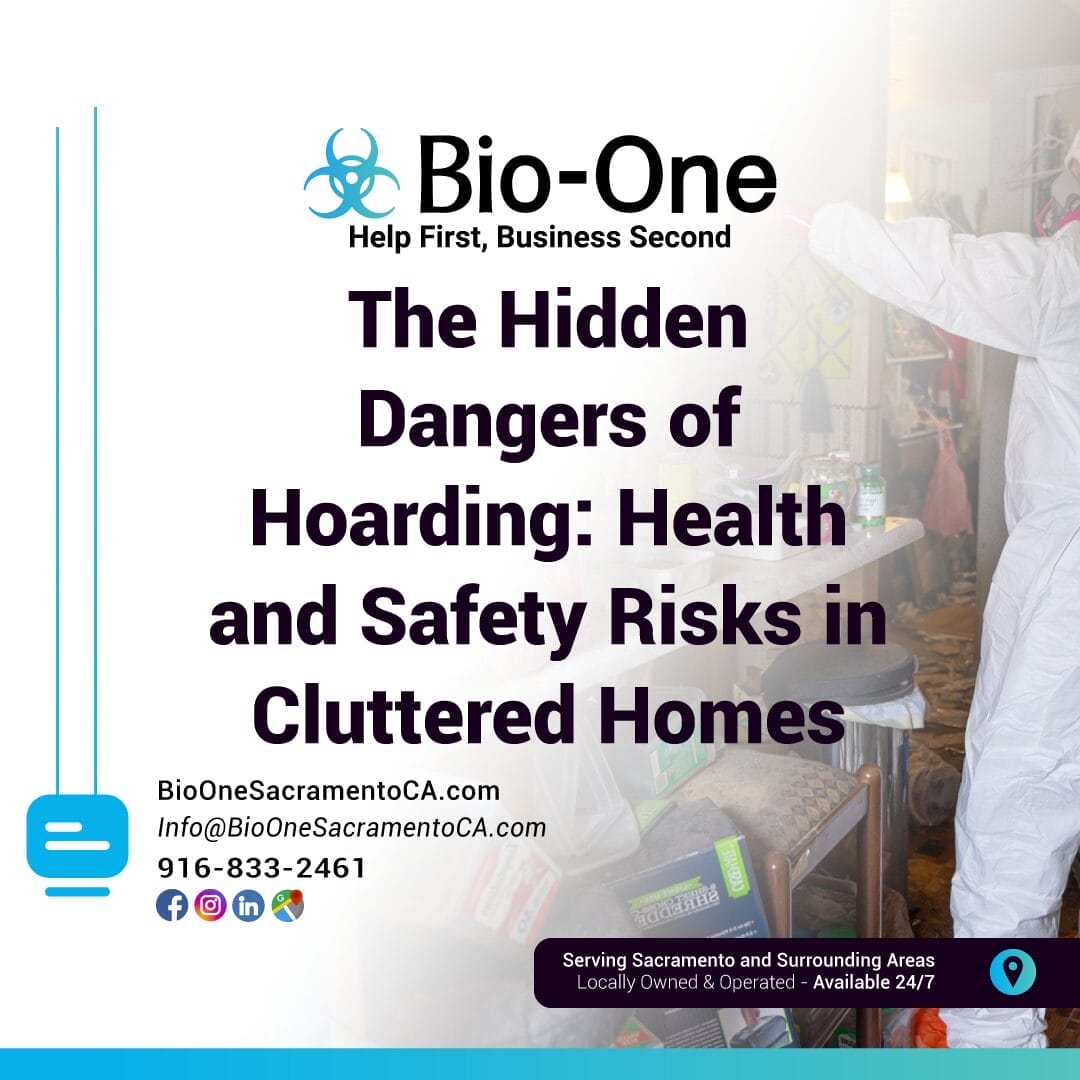
When most people think of hoarding, they picture homes piled high with belongings, leaving little room to move. But the dangers of hoarding go far beyond cluttered spaces. Hoarding can create serious health and safety risks for both the individuals living in these conditions and anyone who may enter the home. These hazards often escalate over time, making it critical to address hoarding situations as early as possible. Here, we’ll explore some of the hidden dangers of hoarding and why these scenarios demand immediate attention.
Take, for example, a case where an overloaded electrical outlet sparks a fire in a hoarded living room. The abundance of flammable debris can cause the fire to spread rapidly, making it harder for firefighters to get the situation under control. Additionally, these homes may prevent emergency personnel from safely entering or navigating the property during rescue efforts.
One of the most pressing dangers in hoarded homes is the increased risk of fire. Excessive clutter, often made up of flammable materials such as paper, clothing, and cardboard, creates a larger fuel source for fires. Not only does this increase the risk of a fire starting, but it also makes escaping a burning home almost impossible. Narrow pathways and blocked exits can trap residents inside during emergencies, endangering their lives.
Hoarded homes often harbor biohazards that pose threats to physical health. Items like spoiled food, pet waste, and even human waste in extreme cases can create environments ripe for the growth of mold, bacteria, and other harmful pathogens. These hazards can lead to respiratory issues, skin infections, and other illnesses for residents who spend long periods in these conditions.
For example, a hoarded kitchen stacked with expired food and trash may attract disease-carrying bacteria or lead to toxic air quality over time. Even something as simple as walking barefoot in such an environment can expose individuals to cuts and wounds that are prone to infection.
Hoarded spaces are a magnet for pests such as rodents, cockroaches, and insects. These creatures are drawn to the cluttered piles, which offer food, water, and hiding spaces in abundance. Unfortunately, pests don’t just invade the home; they carry diseases, chew through walls and wiring, and leave residents vulnerable to bites, stings, and allergic reactions.
A well-documented example is the case of a hoarded home infested with rats. The rodents gnawed through electrical cables, increasing fire risks, and their droppings left an overwhelming stench that posed respiratory health concerns. Such infestations can spread beyond the hoarded home and affect neighbors in the area as well.
The excessive weight and uneven distribution of hoarded items can impact the structural integrity of a home. Floors may buckle under heavy stacks of belongings, and ceilings may sag under the pressure of attic hoards. This kind of damage puts not only the resident at risk but also anyone who visits the property, including neighbors and emergency responders.
For example, in one case, a second-story bedroom overcrowded with hoarded items caused the floor to cave in, damaging the home’s foundation and putting the residents’ lives in danger. Repairing such damage often costs tens of thousands of dollars, further compounding the challenges associated with hoarding.
Not all dangers in hoarded homes are physical. The stress and anxiety caused by living in such conditions are immense. Those struggling with hoarding often feel guilt, shame, and isolation, which can worsen existing mental health conditions like depression or anxiety. For family members and loved ones, the emotional toll of seeing someone live in unsafe conditions is equally significant.
The longer hoarding persists, the worse these dangers become. Addressing these situations requires a compassionate and professional approach. For individuals and families dealing with hoarding, seeking help can feel overwhelming—but it’s an essential step toward restoring safety and well-being.
At Bio-One of Sacramento, we specialize in hoarding cleanup services that prioritize care, discretion, and safety. Our trained professionals know how to handle even the most extreme hoarding situations, ensuring that homes are restored to safe, livable conditions. From removing contaminated items to addressing biohazards and structural concerns, we’re here to help every step of the way.
If you or someone you know is living in a hoarding situation, don’t wait for the risks to multiply. Contact Bio-One of Sacramento today to learn more about our compassionate cleanup services.

Homeless encampments, while often a necessity for those without permanent shelter, can pose significant safety and health risks to both residents and the surrounding community. The conditions of these encampments often give rise to specific hazards that, if left unaddressed, can compromise public safety, harm the environment, and create long-lasting challenges. Here, we’ll take a closer look at the hazards found in homeless encampments and provide practical approaches to addressing them, with an emphasis on why professional cleanup services play a critical role.
One of the most alarming hazards in homeless encampments is the presence of discarded sharp objects, such as broken glass, razor blades, and used syringes. Drug paraphernalia, including needles, poses serious health risks, as these items can carry infectious diseases like Hepatitis B, Hepatitis C, and HIV. A single accidental puncture wound during cleanup can result in life-altering consequences.
Homeless encampments often lack proper sanitation facilities, leading to the accumulation of human waste, spoiled food, and bodily fluids. These biohazards can foster the growth of harmful pathogens, posing risks such as respiratory illnesses, skin infections, and gastrointestinal issues for anyone coming into contact with the area.
If you encounter a homeless encampment with potential biohazards or unsafe conditions, it is essential to contact the appropriate authorities or organizations equipped to address the situation effectively. Here are some key points of contact:
It’s important to act responsibly and with compassion when addressing these circumstances, ensuring the welfare of both those experiencing homelessness and the surrounding community.
The accumulation of waste in homeless encampments creates the ideal environment for pests like rats, cockroaches, and flies. Rodents, in particular, are carriers of diseases such as leptospirosis and hantavirus. Left unchecked, these pests can affect not only the encampment but also surrounding homes and businesses.
Encampments often include temporary shelters made from scavenged materials, which can develop structural problems, especially during extreme weather events. Collapsing structures may result in injuries, and fires from makeshift heating or cooking setups are an ongoing concern.
Given the wide range of hazards found in homeless encampments, addressing them thoroughly and safely is best left to specialized professionals. Companies like Bio-One of Sacramento are equipped with the knowledge, tools, and experience to handle such complex situations. From removing hazardous materials to disinfecting biohazard-contaminated areas, professional crews ensure that cleanup is not just effective but also compassionate and in adherence to health and safety regulations.
If you’re a property owner, business manager, or community leader dealing with the hazards found in homeless encampments, the risks of handling cleanup on your own far outweigh the cost of hiring professionals. At Bio-One of Sacramento, we are committed to providing safe, efficient, and respectful solutions tailored to your unique needs.
Don’t wait for hazards to escalate. Contact Bio-One of Sacramento today to learn more about our homeless encampment cleanup services. Together, we can restore safe and healthy spaces for everyone involved.

Grief is a deeply personal and often overwhelming experience. Whether it's the loss of a loved one, a friend, or even a cherished pet, the process of grieving can take many forms and affect everyone differently. For those of us supporting a friend or family member who is grieving, it can feel challenging to know what to say or do. How can we truly help without overstepping? How can we provide comfort without saying the wrong thing?
This blog offers practical suggestions to help you better support someone experiencing grief while also reminding you that you don’t have to face these moments alone. Services like Bio-One of Sacramento are here to offer guidance and connect you with the right resources for dealing with grief and navigating these emotional times.
Grief is not a one-size-fits-all process. It manifests differently depending on the person, their relationship with the loss, and cultural or spiritual beliefs. Common emotional responses include sadness, anger, guilt, numbness, and confusion. Physical symptoms, like fatigue, difficulty sleeping, and changes in appetite, are also common.
You’ve likely heard of the five stages of grief (denial, anger, bargaining, depression, and acceptance) introduced by psychiatrist Elisabeth Kübler-Ross. While helpful as a framework for understanding grief, remember that these stages are not necessarily linear. Many individuals move back and forth between them or experience them in a different order.
When someone you care about is grieving, you want to be there for them—but what does being supportive actually look like? Here are some tangible ways to help:
Sometimes, the best thing you can do is simply sit with someone in their pain. You don’t need to offer solutions or platitudes. Instead:
Grief can be paralyzing, and everyday tasks may seem overwhelming for someone who is grieving. Show your support by taking action:
These small gestures go a long way in lightening their load.
Grief doesn’t come with a timeline. Avoid pressuring your loved one to “get over it” or move on. Instead:
Grief is heavy, and healthy outlets can help someone cope. Encourage activities such as:
If your loved one needs additional support, suggest counseling or loss support groups, such as those we can connect you to through our network at Bio-One of Sacramento.
There are times when grief becomes too overwhelming for a friend or family member to support alone. Situations involving traumatic losses, such as those with unexpected or violent elements, may require professional help. At Bio-One of Sacramento, we specialize in assisting families during these challenging times with compassion and professionalism.
We can connect grieving individuals with specialized resources, such as:
Our mission is “Help First, Business Second,” and that principle extends beyond our cleanup services. We’re here to ease burdens and make difficult times a little more manageable.
Grief can feel isolating, but support, connection, and kindness can make all the difference. A sense of community—whether it’s a circle of neighbors, friends, or colleagues—provides grieving individuals with a safety net.
If you're part of a community group or workplace, consider ways to show collective support for someone grieving:
At Bio-One of Sacramento, we've witnessed the incredible power of community support firsthand, and we encourage everyone to foster connections during times of loss.
Supporting someone through grief isn’t about finding the perfect words or gestures. It’s about showing up, offering kindness, and providing consistent support. Here’s how you can take action today:
Remember, grief is a universal experience, but it’s made lighter when shared with care and compassion.
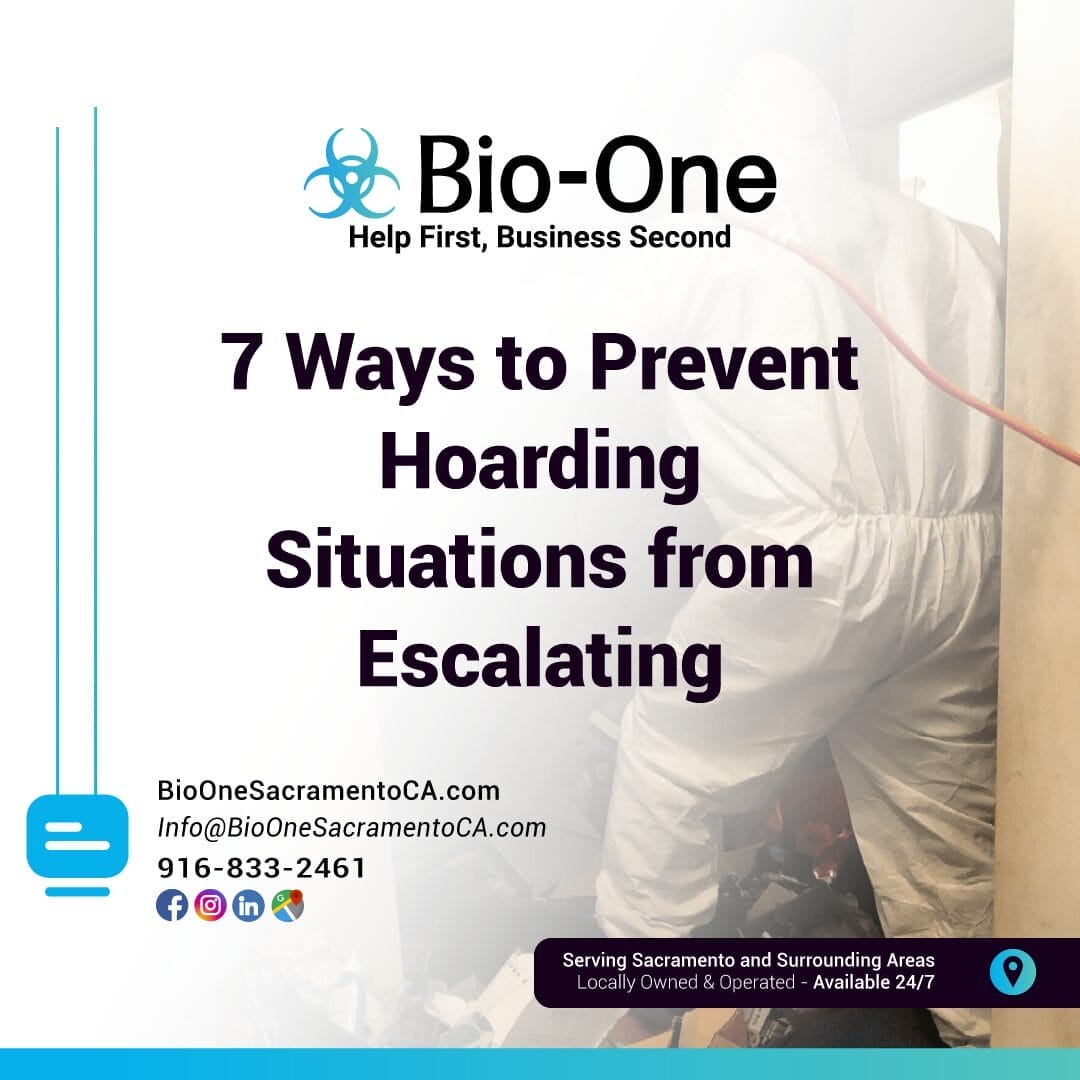
Hoarding is often rooted in emotional or psychological challenges. For those at risk, the consequences can spiral out of control, affecting their physical and mental health, relationships, and living conditions. If you’re a family member, caregiver, or someone concerned about hoarding, you’re in the right place. This article shares practical, compassionate prevent hoarding situations from escalating while offering support and understanding to those who need it. Let's take a closer look at strategies that can make a meaningful difference.
Hoarding disorder is characterized by persistent difficulty discarding or parting with possessions, regardless of value. What sets it apart from ordinary clutter is the significant distress or impairment it causes in daily life—blocking living spaces, creating safety hazards, and straining relationships.
It’s important to note that hoarding is often not a “lifestyle choice.” Instead, it may stem from underlying conditions like anxiety, depression, or trauma. A compassionate, non-judgmental approach is key when supporting someone struggling with hoarding.
When hoarding tendencies go unaddressed, they can quickly worsen. Clutter can pile up to the point where it creates health risks, such as fire hazards, infestations, or blocked pathways. Additionally, emotional distress often intensifies, leaving individuals isolated and overwhelmed.
The good news? With early intervention and empathetic support, families and caregivers can help those at risk manage their behaviors before things spiral out of control.
Below are actionable hoarding prevention tips that will empower you to help a loved one—or yourself—while fostering a positive and supportive environment.
The earlier you identify hoarding behaviors, the easier it becomes to prevent escalation. Look out for signs such as:
If you notice these tendencies, approach the individual with kindness and understanding, never judgment. Recognizing the issue early is the first step toward improvement.
Hoarding often thrives in secrecy. Encourage open, non-judgmental conversations about how your loved one feels about their belongings and why they find it hard to part with them.
Helpful phrases you can use:
Ensure that the person feels heard and respected. Building trust lays the foundation for addressing hoarding behaviors collaboratively.
Combatting hoarding doesn’t happen overnight. Instead of tackling the entire issue at once, break the process into manageable steps. For example:
Progress takes time, and it’s important to acknowledge and praise every step in the right direction.
Many individuals who hoard struggle with deciding what to keep and what to discard. Simplify the process by providing a framework they can follow:
Encourage sorting items into clearly labeled categories, such as “keep,” “donate,” “discard,” and “undecided.” This approach reduces the feeling of overwhelm and provides structure.
Hoarding disorder often requires more than just well-meaning support from loved ones. Therapy and professional hoarding cleanup companies can provide valuable tools and perspectives to address the root causes.
It’s okay to acknowledge that some issues are best addressed with the help of trained professionals.
It’s important to remember that hoarding is deeply emotional. Applying pressure or insisting that someone “just get rid of it” is counterproductive and can lead to further resistance.
Instead, offer steady emotional support, letting your loved one know they’re not alone in this process. Statements like "What matters to you matters to me" can go a long way in building trust.
Once progress has been made, it’s essential to implement strategies to prevent relapse, such as:
Creating lasting habits empowers individuals to sustain the gains they’ve made over time.
Addressing hoarding situations can be challenging, but it’s important to remember that transformation begins with understanding. Whether you’re a caregiver, family member, or someone struggling personally, compassionate intervention and small, consistent actions can prevent hoarding from spiraling out of control.
If you or a loved one need additional support, please consider reaching out to Bio One of Sacramento. Our professional and understanding team specializes in compassionate hoarding cleanup services, offering support every step of the way to help restore spaces and peace of mind.
Taking the first step might seem daunting, but with patience and care, positive change is possible.
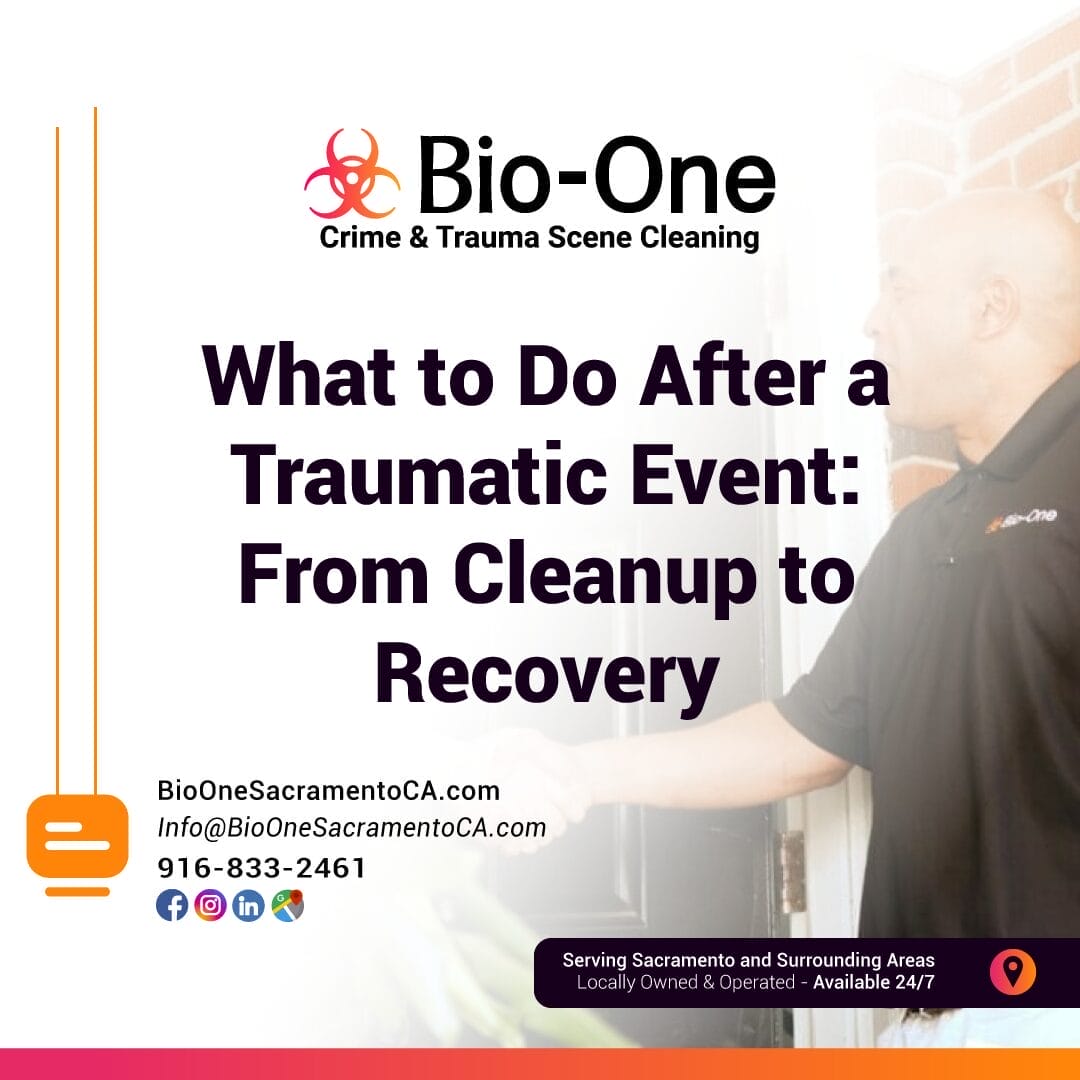
Experiencing a traumatic event is an overwhelming and life-changing moment. Whether it’s a crime scene, accidental death, or significant biohazard exposure, the aftermath can feel impossible to face. Knowing how to respond can make a huge difference in protecting your well-being and beginning the healing process. Here's a compassionate and clear guide to navigating trauma cleanup and recovery with out professional cleanup services.
The first and most important step after a traumatic event is ensuring safety for yourself and others.
One of the most important steps in trauma cleanup and recovery is working with trained professionals who specialize in cleanup services.
The emotional toll of a traumatic event can last long after physical cleanup efforts are complete. Prioritize your mental health as part of the recovery process.
The road to recovery is difficult but not impossible. Here are a few considerations as you continue to rebuild your sense of normalcy.
Dealing with a traumatic event is never easy, but you don’t have to face it alone. Taking immediate safety precautions, enlisting professional trauma cleanup services, and prioritizing your emotional recovery can help you start the healing process. Remember, when you work with experienced cleanup professionals, not only are your physical surroundings restored, but you also gain the peace of mind to focus on what matters most–your recovery.
If you need support during this difficult time, Bio-One of Sacramento is here for you. Our team is available 24/7 to provide compassionate, discreet, and professional cleanup services. You don’t have to walk this road alone. Reach out today for the help you deserve.